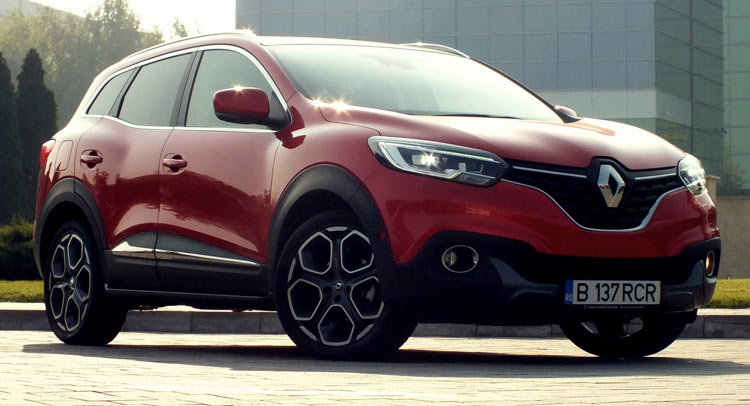The Kadjar is marketed as a compact crossover, which means it will have to battle the likes of the Mitsubishi ASX and the Mazda CX-5 in the rapidly growing segment.
It also replaces the Koleos and it’s closely related to the Qashqai, with the Renault Nissan Alliance making the best of platform sharing.
However, unlike its Japanese cousin, the Kadjar is larger and closer to the Qashqai’s bigger brother, the X-Trail. Having driven its most interesting version, we try and figure out how Renault’s latest crossover fares in this very competitive class.
Looking Good, Are We?
Renault designers have done a pretty good job on their new crossover, It has a front fascia similar to the one seen on the Clio IV, an aggressive hood, soft lines running across its side, a slightly sloping roofline and a clean tailgate with sleek-looking taillights.
The plastic body cladding comes with the territory and it’s a telltale that it’s capable of leaving the tarmac. However, if potential buyers are interested in driving off-road, then the wheels and the low-profile tires need to be changed as they are strictly for road use. Speaking of which, they don’t excel there either, because speed bumps will become more obvious than ever.
Road manners and soft roading
In a few words, surprisingly good, and it would ride even better with higher-profile tires. They might not look as good, but they should be working much better for a daily commuter.
The Kadjar brakes just like a compact hatchback and it doesn’t feel as heavy as the Mitsubishi ASX (Outlander Sport). Cornering comes natural and it’s superior even to Mazda’s CX-5; this is something the engineers should be praised for, because they have successfully tweaked the modular CMF platform to suit the compact crossover’s needs.
The test car came with a 1.6-liter dCi diesel engine rated at 130PS (128hp) and 320Nm (236lb-ft) of torque. On paper it looks underpowered, but this is not the case. The engine provides enough torque at low revs and it is probably one of the best diesel engines Renault has ever put together.
It’s mated to a six-speed manual transmission and, in this variant, it sends power to the all-wheel drive system. Mind you, it’s not a permanent AWD but, like most crossovers, the driver can select between 2WD, Auto and Lock (for better off-road traction).
That said, you may want to tread carefully when leaving the road. The Kadjar lacks a low-range gearbox or a suspension that can cope with a steep terrain, but it’s more than enough for soft-roading and it will gladly tackle surfaces most of its buyers will drive on.
Mind Your Right Food
Renault that the 1.6 dCi 4×4 version’s consumption stands at 5.4 lt/100km urban, 4.4 lt/100km extra urban and 4.8 lt/100km average (43.6 / 53.5 / 49 mpg US). In the real world, things are a bit different. The trip computer indicated close to 7 lt/100km (34 mpg) after a few days of city driving with the AC off, while on the highway, at a legal speed of 130 km/h (81 mph), it couldn’t best 6.5 lt/100km (36 mpg). However, drop to, say, 80 to 90 km/h (50-56mph), and you will surprised to see the official fuel consumption figure indicated right in front of you. You’ll obviously need a bit longer to get to your destination, though, and get bored of being overtaken…
Family Matters
If you have ever seen the cabin of a previous-gen Megane, a Clio or a Captur, you know what to expect from a range-topping Kadjar.
Being a plush version, it comes with leather on most surfaces with contrast stitching, a multi-function steering wheel, an instrument cluster that indicates whatever one needs to know on the drive, a dual-zone climate control added to the package and the R-Link 2 infotainment system with a 7-inch touch screen that offers the Birdview (2.5D) navigation system with the European map included, internet connectivity with dedicated apps (12 months free subscription).
The driving position needs lots of fiddling with the controls to get it right, but on the bright side It does gives a clear view of the vehicle’s front end. Every button is in close reach of the driver, but you won’s need anything except for what’s on the multi-function steering wheel, most of the time at least. As a nice touch, Renault offers a panoramic roof, which is worth every penny. The model comes with functional cup holders and a place to store smartphones with a 5+in display.
The rear seat can host two adults comfortably for a long drive, with a sliding armrest between them. Add a third passenger and things, predictably, get a bit crowded. Headroom is more than enough and so is legroom, even with a tall driver behind the wheel.
Boot space is OK (472L / 16.7cubic feet) for a small family going on a vacation with two children and, similar to the Captur, the Kadjar has an extra storage space below the boot floor. Don’t expect anything huge, but it will allow you to easily store a few things that you wish to remain hidden from view.
Love It Or Leave It?
The ride is comfortable, the interior space is more than enough, most materials are similar to what is found on older premium crossovers and both performance and fuel consumption are more than decent. It also corners well and it’s well-equipped.
On the other hand, the driving position takes time to get used to and if you need extra performance, well… you cannot have it, because the 130 PS diesel is the most powerful in the range.
Safety – 5 Stars from Euro NCAP
Price – entry-level ~€18,000 ($19,543) / test car ~€27,750 ($30,128)
Image Credits: Cristian Gnaticov / Carscoops.com































































